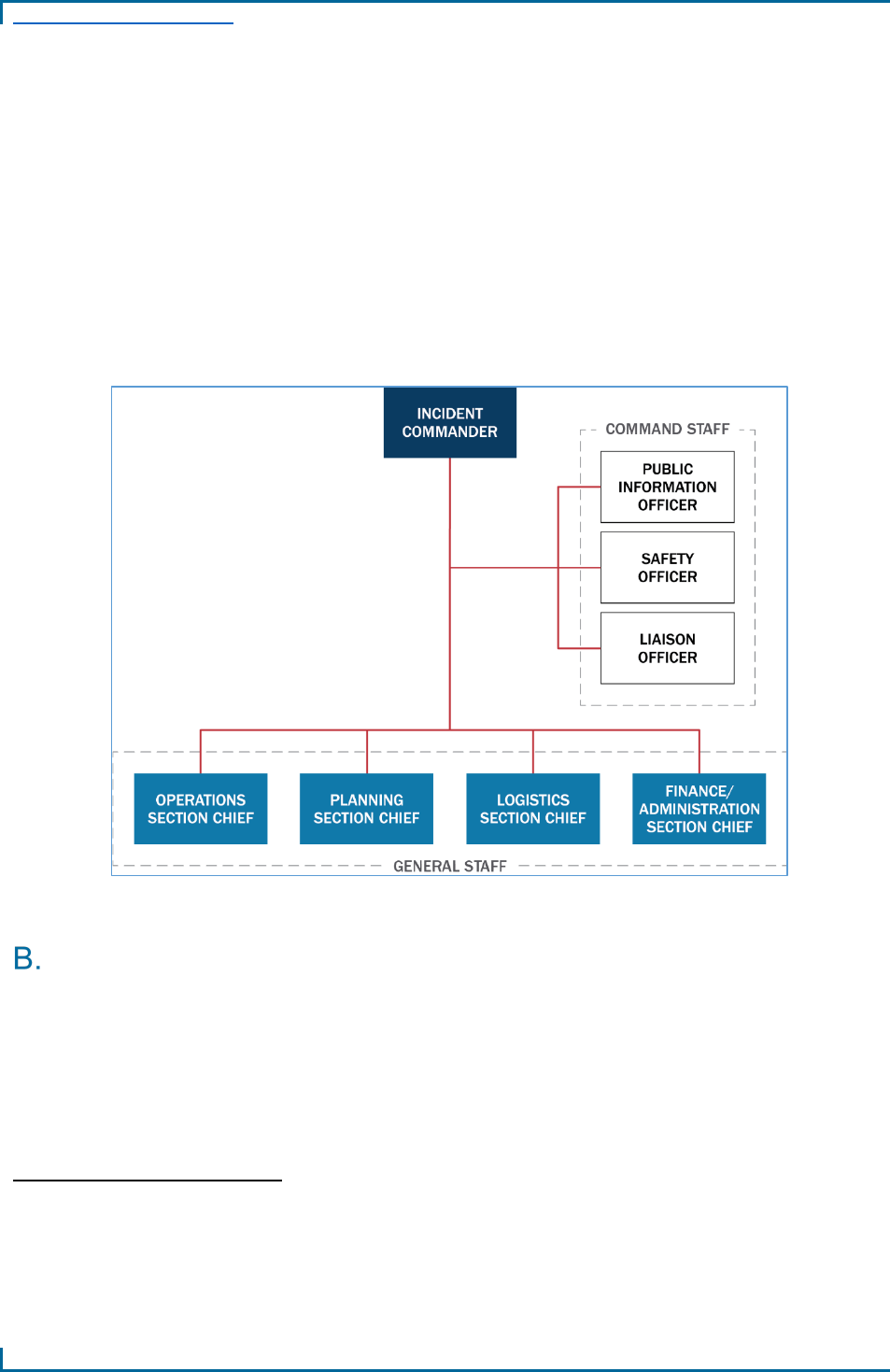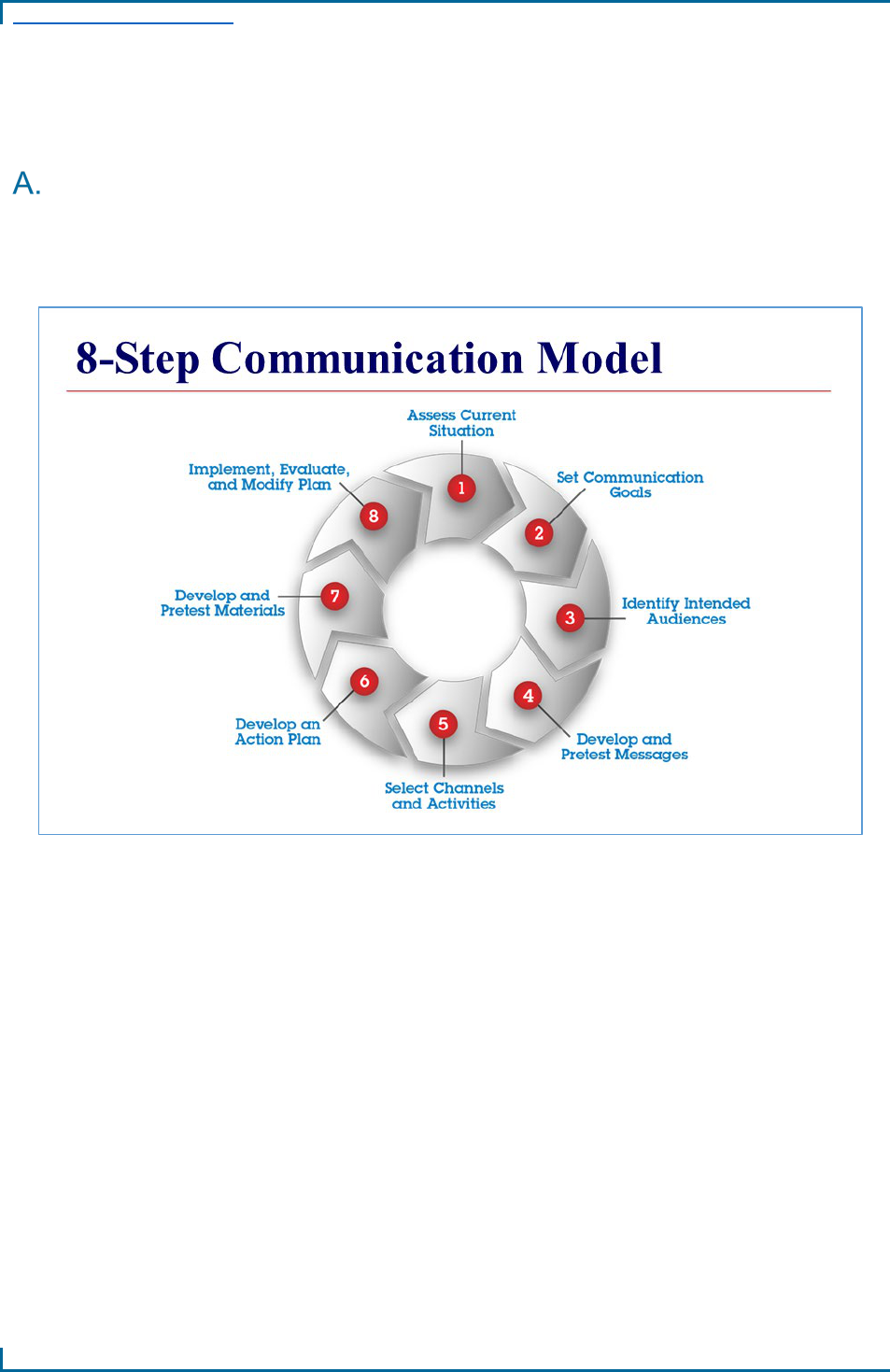
1
National Incident Management
System Basic Guidance for
Public Information Officers
December 2020

ii
Contents
I. Introduction ........................................................................................................................ 1
II. NIMS Overview .................................................................................................................. 2
III. Command and Coordination ............................................................................................ 3
Incident Command System (ICS) ..................................................................................................... 3
Emergency Operations Center (EOC) ............................................................................................... 4
Multiagency Coordination Group (MAC Group) ............................................................................. 5
Joint Information System (JIS) ......................................................................................................... 5
Integrating with Federal Support ...................................................................................................... 8
IV. Preparedness .................................................................................................................... 10
Risk Communication Campaigns .................................................................................................... 10
Training ........................................................................................................................................... 10
Exercises ......................................................................................................................................... 11
Media Relations .............................................................................................................................. 11
Considerations for People with Disabilities or Access and Functional Needs (AFN) .................... 11
Communications Equipment and Resources ................................................................................... 12
Contact Lists ................................................................................................................................... 13
Go-Kits ............................................................................................................................................ 13
Additional Public Information Support ........................................................................................... 14
V. Response............................................................................................................................ 15
Responsibilities ............................................................................................................................... 15
Crisis Communications Development ............................................................................................ 16
Public Information Considerations ................................................................................................. 18
VI. Strategic Communication ................................................................................................ 20
The 8-Step Process .......................................................................................................................... 20
VII. Recovery............................................................................................................................ 23
Recovery-Related Public Information ............................................................................................ 23
Guidance for PIOs ........................................................................................................................... 23
VIII. Digital Communications .................................................................................................. 25
Social Listening .............................................................................................................................. 25
Posting Social Media Content ......................................................................................................... 27
IX. Conclusion ........................................................................................................................ 31
Appendix A. PIO Resources ................................................................................................... 32

NIMS Basic Guidance for Public Information Officers FEMA-[email protected]
1
I. Introduction
FEMA developed this guidance in coordination with Federal, state, local, tribal, territorial,
private sector, and nonprofit Public Information Officers (PIO).
1
This publication provides
operational practices to help PIOs perform their duties within the National Incident Management
System (NIMS) Command and Coordination structures.
Before, during, and after an incident,
2
coordinated and timely communication to the public is
critical. Effective communication can save lives and property, and can promote credibility and
public trust. PIOs are key members of Incident Command System (ICS) and Emergency
Operations Center (EOC) organizations, and they work closely with officials who are part of
Multiagency Coordination Groups (MAC Groups). PIOs advise the Incident Commander (IC),
Unified Command, and EOC director
3
on public information relating to incident management.
PIOs also handle the following:
• Inquiries from the media, the public, and elected officials
• Public information and warnings
• Rumor monitoring and response
• Media relations
• Digital communications
• Multimedia content
• Other functions necessary to gather, verify, coordinate, and disseminate accurate, accessible,
and timely information (information on public health, safety, and protecting private property
is particularly important)
• Monitoring media and other sources of public information and transmitting relevant
information to appropriate personnel at the incident site, in an EOC, or in a MAC Group
This document also discusses actions related to preparedness, incident response, Joint
Information Systems (JIS), Joint Information Centers (JIC), incident recovery, and Federal
public information support.
This Basic Guidance for Public Information Officers provides fundamentals for any person or
group with PIO responsibilities. The material is adaptable to individual jurisdictions and specific
incident conditions. This guide is not a substitute for initial and ongoing PIO training. Basic and
advanced PIO training is available through many state emergency management departments and
FEMA.
Supersession: This document supersedes NIMS Basic Guidance for Public Information Officers
issued in November 2007.
1
EOC PIOs can have a variety of titles; for clarity, this document uses PIO throughout.
2
In this document, the word incident includes planned events plus emergencies and disasters of all kinds and sizes.
3
For position descriptions, see the Resource Typing Library Tool (RTLT): https://rtlt.preptoolkit.fema.gov/Public.

FEMA-[email protected] NIMS Basic Guidance for Public Information Officers
2
II. NIMS Overview
Communities across the nation experience a diverse range of threats, hazards, and events. The
size, frequency, complexity, and scope of these incidents vary, but all involve an array of
personnel and organizations coordinating efforts to save lives, stabilize the incident, and protect
property and the environment.
Every day, jurisdictions and organizations work together to share resources, integrate tactics, and
act collaboratively. Whether these organizations are in close proximity or across the country,
their success depends on a common, interoperable approach to sharing resources, coordinating
and managing incidents, and communicating information. NIMS defines this comprehensive
approach.
NIMS guides people and organizations in all levels of government, Nongovernmental
Organizations (NGO), and the private sector to work together to prevent, protect against,
mitigate, respond to, and recover from incidents. The system gives stakeholders across the whole
community the shared vocabulary, structures, and processes to successfully deliver the
capabilities described in the National Preparedness System (NPS). NIMS defines the operational
systems—including the ICS, EOC structures, and MAC Groups—that guide how personnel work
together during incidents. NIMS applies to all incidents, from planned events to traffic accidents
to major disasters.

NIMS Basic Guidance for Public Information Officers FEMA-[email protected]
3
III. Command and Coordination
NIMS describes Command and Coordination systems, principles, and structures that provide a
standard, national framework for incident management. Regardless of an incident’s size,
complexity, or scope, effective command and coordination—using standard, flexible processes
and systems—helps save lives and stabilize the situation. NIMS Command and Coordination
consists of four areas of responsibility:
1. Tactical activities to apply resources on the scene
2. Incident support, typically conducted at EOCs,
4
through operational and strategic
coordination, resource acquisition, and information gathering, analysis, and sharing
3. Policy guidance and senior-level decision-making
4. Outreach and communication to keep the media and public informed about the incident
At all levels of incident management, public information personnel are responsible for gathering,
analyzing, and proactively disseminating information to ensure accurate, timely updates on the
incident or event. See Table 1 for a summary of PIO functions.
Table 1: Summary of PIO Functions
Major ICS Position Primary Functions
Public Information
Officer (PIO)
● Proactively develop accurate, accessible, and timely information for use in
press/media briefings, written media releases, or web and social media
posts
● Monitor information from traditional media, the web, and social media that
is relevant to incident planning and forward it as appropriate
● Understand and advise incident command on any necessary limits on
information release
● Obtain the IC’s approval of public materials
● Conduct and prepare officials for media briefings
● Arrange for tours, community outreach events, interviews, and briefings
● Make information about the incident available to incident personnel
● Participate in planning meetings
● Identify and implement rumor control methods
Incident Command System (ICS)
The ICS integrates facilities, equipment, personnel, procedures, and communications into a
common organizational structure. ICS applies to a variety of incidents, organizations, and
government entities at all levels.
4
Incident support takes place in a wide variety of facilities, including virtual structures. NIMS uses the term EOC to
refer to all such facilities, including emergency coordination centers.

FEMA-[email protected] NIMS Basic Guidance for Public Information Officers
4
The PIO interfaces with the public, media, various agencies, and the private sector to meet
incident-related information needs. The PIO gathers, verifies, coordinates, and disseminates
accessible,
5
meaningful, and timely information about the incident for internal and external
audiences. The PIO also monitors the media and other sources of public information to collect
incident-related information and transmits this information to the appropriate representatives in
the incident management organization. Figure 1 illustrates the PIO’s role in an ICS.
In incidents that involve PIOs from different agencies, the IC or Unified Command designates
one person as the lead PIO. All PIOs work in a unified manner, speaking with one voice and
ensuring consistent messaging. The IC, in collaboration with the lead PIO, approves the release
of incident-related information. In incidents involving multiple agencies, leadership may
establish a JIC. The PIO participates in or leads the JIC.
Figure 1: Example of the PIO’s Role in an ICS Organization
Emergency Operations Center (EOC)
For jurisdictions and organizations across the nation, an EOC forms an important element of
their emergency management program. An EOC is a location where staff from multiple agencies
come together to address imminent threats and hazards, and to provide coordinated support to
incident command, on-scene personnel, and other EOCs. EOCs may be fixed locations,
temporary facilities, or virtual structures with remote staff.
5
The PIO ensures that public information is accessible to all individuals, including those with limited English
proficiency (LEP) and those with disabilities or other access and functional needs (AFN). Members of the public
who have disabilities or AFN or who have LEP should have comparable access to and use of public information as
those who do not have disabilities or other AFN.

NIMS Basic Guidance for Public Information Officers FEMA-[email protected]
5
Primary functions of staff in an EOC, whether virtual or physical, include the following:
• Collect, analyze, and share information
• Support resource needs and requests, including allocation and tracking
• Gather 508-compliant
6
information and share it with local EOCs, nonprofit partners, and
other organizations to promote efficient, accessible, and effective communication during an
incident
• Coordinate plans and determine current and future needs
• In some cases, provide coordination and policy direction
EOCs are great places for PIOs to gather multidisciplinary situational awareness and coordinate
information across multiple disciplines.
Multiagency Coordination Group (MAC Group)
MAC Groups, sometimes called Policy Groups, are part of the off-site incident management
structure of NIMS. A MAC Group includes representatives from stakeholder agencies and
organizations. The group is organized to make cooperative multiagency decisions and
communicate current, accurate, and accessible information to the public. MAC Groups act as
policy-level bodies during incidents, supporting resource prioritization and allocation, and
enabling decision-making among elected officials, appointed officials, and incident managers
such as the IC.
Regardless of a MAC Group’s composition, EOC teams also receive guidance from elected or
appointed officials such as governors, tribal leaders, mayors, and city managers. These leaders
may be present in the EOC, but they usually provide guidance from elsewhere, either as part of a
formal Policy Group or individually. They typically make decisions about priorities and issues
such as emergency declarations, large-scale evacuations, access to extraordinary emergency
funding, waivers for ordinances, regulations and other legal issues, and adjudication of scarce
resources.
Joint Information System (JIS)
Dissemination of timely, accurate, accessible, and actionable information to the public is
important at all phases of incident management. Many agencies and organizations at all levels of
government develop and share public information. Jurisdictions and organizations coordinate
and integrate communication efforts to ensure that the public receives a consistent,
comprehensive message.
The JIS consists of the processes, procedures, and tools that facilitate communication to the
public, incident personnel, the media, and other stakeholders (people or groups that have an
6
Section 508, an amendment to the Rehabilitation Act of 1973, is a Federal law mandating that Federal agencies
ensure that all electronic and information technology (IT) that they develop, procure, maintain, or use be accessible
to people with disabilities or access and functional needs (AFN). Section 508 compliance therefore involves making
websites accessible to people with limited vision or blindness, deafness, seizure disorders, and other disabilities or
AFN.

FEMA-[email protected] NIMS Basic Guidance for Public Information Officers
6
interest in or could benefit from a PIO’s work). The JIS integrates incident information and
public affairs into a cohesive organization to provide complete, coordinated information before,
during, and after an incident. The JIS mission is to provide a structure and system to help PIOs
complete the following tasks:
• Develop and deliver coordinated interagency messages
• Develop, recommend, and execute public information plans and strategies on behalf of the
IC, Unified Command, MAC Group, and EOC director
• Advise the IC, Unified Command, MAC Group, and EOC director concerning public affairs
issues that could affect the incident management effort
• Address and manage rumors and inaccurate information that could undermine public
confidence and interfere with emergency response or incident operations
A JIS cuts across the three levels of incident management—on-scene/tactical,
center/coordination, and policy/strategic—and helps ensure coordinated messaging among all
incident personnel. PIOs should agree on how to divide their responsibilities to avoid gaps or
duplication of efforts. Ideally, PIOs will coordinate before an incident occurs and document their
decisions in the jurisdiction’s or organization’s emergency operations plan.
System Description and Components
Public information leaders prepare for incidents by coordinating their processes, plans, protocols,
procedures, and structures in advance. PIOs at all levels of government and within the private
sector, nonprofit sector, and JICs are important supporting elements of the JIS. Key elements of
the JIS include the following:
• Interagency coordination and integration
• Gathering, verifying, coordinating, and disseminating consistent messages
• Integrating messaging from various levels of incident management
• Providing public affairs support for decision makers
• Ensuring flexibility, modularity, and adaptability
Joint Information Center (JIC)
The JIC is a facility that houses JIS operations. This is where personnel with public information
responsibilities perform essential public information and public affairs functions. Leaders can
establish a JIC as a standalone coordination entity, as a component of an EOC, or virtually.
Depending on incident needs, an incident-specific JIC can arise either on-scene (through local,
state, and federal agency coordination) or at the national level. A national JIC may be necessary
when an incident includes federal coordination and is expected to last for weeks or months, or
when the incident affects a large geographic area.
PIOs prepare public information releases for IC, Unified Command, EOC director, or MAC
Group review. This helps ensure consistent messages, avoids release of conflicting information,
and prevents adverse impact on operations. Jurisdictions and organizations can issue public
information materials (such as statements, talking points, or social media messaging strategy)

NIMS Basic Guidance for Public Information Officers FEMA-[email protected]
7
related to their policies, procedures, programs, and capabilities; however, they should coordinate
these efforts with the incident-specific JICs.
Typically, a single JIC is sufficient, but the system is flexible enough to accommodate multiple
physical or virtual JICs. For example, multiple JICs may be necessary for a complex incident
covering a wide geographic area or multiple jurisdictions. When leaders activate multiple JICs,
staff in the JICs are responsible for:
• Following established procedures and protocols for effective communication and
coordination
• Determining the final release authority
JICs can be organized in many ways, depending on the nature of the incident. Table 2 describes
various types of JICs.
Table 2: Examples of JIC Types
Type Characteristics
Incident JIC
● Optimal physical location for local, IC, Unified Command, and EOC director-
assigned PIOs to co-locate
● May be located at an EOC
● Media access is paramount
Virtual JIC
● Established when physical co-location is not feasible
● PIOs operate from multiple, dispersed locations
● Incorporates technology and communications protocols
Satellite JIC
● Smaller in scale than other JICs
● Established to support the primary JIC
● Operates under the primary JIC’s control
Area JIC
● Supports wide-area, multiple-incident ICS structures
● Could be established locally or statewide
● Media access is paramount
National JIC
● Typically established for large or long-duration incidents
● Established to support federal incident management
● Staffed by numerous federal departments and agencies
● Should be integrated with local and state JICs
● Media access is paramount
PIO Function in the JIC
In JICs, PIOs create coordinated and consistent messages by collaborating to:
• Identify key information to be communicated to the public
• Craft clear messages in plain language that all can understand, including people with limited
English proficiency (LEP), with disabilities, or with access and functional needs (AFN)
7
7
PIOs should provide messaging in multiple formats to meet the communication needs of people with disabilities or
AFN, who have LEP, who have diverse cultural backgrounds, who have cognitive limitations, or who do not use
traditional media.

FEMA-[email protected] NIMS Basic Guidance for Public Information Officers
8
• Prioritize messages to ensure timely delivery of information without overwhelming the
audience
• Verify information accuracy
• Disseminate messages using the most effective means
Organizational Independence
Incident management organizations retain their independence while collaborating through the JIS
to generate common public information. Incident command, EOC leadership, or MAC Group
members may be responsible for establishing and overseeing JICs, including the processes for
coordinating and approving public communications.
Within the JIC, each agency or organization contributes to the overall unified message under the
guiding principle “Many voices, one message.” Departments, agencies, organizations, and
jurisdictions maintain control over information concerning their own programs and policies.
Integrating with Federal Support
Emergency Support Function (ESF) #15
Federal support follows the standard operating procedures of Emergency Support Function
(ESF) #15—External Affairs.
8
ESF #15 integrates and coordinates the functional areas of public
affairs; community relations; local, state, tribal, and territorial affairs; the private sector; and
congressional affairs. Primary leaders for ESF #15 include staff from the U.S. Department of
Homeland Security (DHS) and FEMA, as well as staff from other Federal agencies in specific
response scenarios.
During an operational incident or planned event that requires a coordinated Federal response,
DHS/FEMA staff contact the affected local, state, tribal, and territorial jurisdictions to discuss
their public information needs. Under ESF #15, DHS/FEMA then provides staff and other
resources as necessary, including:
• Satellite trucks and equipment
• Communications equipment
• Media center equipment, such as TVs, computers, podiums, power cords, and microphones
• Personnel
DHS/FEMA encourages local, state, tribal, and territorial entities to work in partnership to
ensure the effective, efficient production and dissemination of emergency information. DHS
encourages entity PIOs to co-locate within the incident JIC to facilitate coordination,
cooperation, and unified messaging.
8
For more information about ESFs and ESF #15, see the FEMA National Response Framework.

NIMS Basic Guidance for Public Information Officers FEMA-[email protected]
9
Communications Protocols
DHS Public Affairs has established the following communications protocols for use during
large-scale incidents or those requiring a coordinated Federal response:
National Incident Communications Conference Line (NICCL)
The NICCL is a standing conference line for interagency communication during an incident
requiring federal coordination. DHS created the NICCL primarily for federal interagency
partners’ executive information sharing, but it is also available to communicators from the
primarily impacted state and local community. Specifically, the NICCL:
• Works as a call-in conference line (typically used once daily) but can also serve as an open
line with 24-hour monitoring, as necessary, to facilitate information sharing and updates
• Primarily promotes communication to support senior state and local officials
• Facilitates executive calls originating with DHS Public Affairs or FEMA External Affairs to
discuss agencies’ roles, activities, and response to current events
State Incident Communications Conference Line (SICCL)
The SICCL is a dedicated conference line for scheduled conference calls between federal and
state incident leaders who need to share information and discuss issues affecting the states
following an incident. Unlike the NICCL, it is not a 24-hour line. Specifically, the SICCL:
• Is designed for use during a multistate disaster, such as a hurricane, in which impacted states
want support from other states and need to coordinate the incident response across state lines
• Facilitates calls originating with DHS Public Affairs or FEMA External Affairs to discuss
incident information targeting state and local communicators
Private Sector Incident Communications Conference Line (PICCL)
The PICCL is a standing line for use by the Critical Infrastructure/Key Resources (CIKR)
incident communications coordinators. DHS Infrastructure Protection and FEMA External
Affairs coordinate access to the line, which provides timely public information to the CIKR
sectors during an incident requiring Federal coordination and response. Specifically, the PICCL:
• Facilitates outreach to top state employers to discuss incident response and recovery
activities
• Helps identify needs and capabilities
• Establishes two-way communications with the private sector
Emergency Management Assistance Compact (EMAC)
Another resource for PIO support is the Emergency Management Assistance Compact (EMAC),
which became law in 1996 (Public Law 104-321). EMAC provides a responsive, straightforward
system that allows states to send personnel, equipment, and commodities to help disaster relief
efforts in other states during governor-declared states of emergency. For more information, see
http://www.emacweb.org.

FEMA-[email protected] NIMS Basic Guidance for Public Information Officers
10
IV. Preparedness
Preparedness is essential for an effective response to an incident or planned event. Public
information efforts, which should begin well in advance of an incident or planned event, can
involve a combination of planning, resource gathering, organizing, training, and exercises.
Public information planning allows PIOs to coordinate and communicate lifesaving measures—
such as evacuation routes, alert systems, and other public safety information—to diverse
audiences in a proactive, timely, consistent manner. Community risk reduction and other public
education efforts help prepare citizens to mitigate or respond to a variety of hazards.
Public information preparedness includes developing and maintaining plans, procedures,
checklists, contact lists, public information materials, and strategic communication plans, and
working with other PIOs to exercise communication plans. The following are important factors a
PIO should consider when developing plans before an incident or planned event.
Risk Communication Campaigns
Risk communication is the process of making the public aware of risks and of how to prepare for
hazards in advance. Risk communication can stand alone but is often a segment of a broader
Community Risk Reduction (CRR) program. CRR involves identifying and prioritizing local
risks, developing an integrated strategy to reduce their occurrence and impact, and implementing
the strategy using emergency response and prevention resources.
Before an incident occurs, PIOs should conduct activities to educate the public about potential
local hazards, prevention, family preparedness, and response activities. It is important for plans
and resource materials to be appropriate for the target audience—for example, children, people
with disabilities or AFN, people with LEP, pet owners, local businesses and employees, or entire
communities.
PIOs can conduct risk communication through special events, community events, media releases,
social media, and print materials or multimedia/digital content. Examples of risk communication
campaigns include:
• All-hazards preparedness
• Family or business emergency plans
• Hazardous materials (HAZMAT) awareness
• Messaging for people with LEP, disabilities, or AFN
• Severe weather awareness
• Exit drills in the home
Training
FEMA encourages PIOs to participate in ongoing emergency management training. This
includes basic public information courses; ICS courses; and training in social media content,

NIMS Basic Guidance for Public Information Officers FEMA-[email protected]
11
listening and engagement, conducting interviews, writing (including nontraditional media,
talking points, and media releases), and understanding the role of a JIC. Prerequisite and
recommended courses are available through the Emergency Management Institute (EMI).
9
Additionally, public information courses that support NIMS are available through other agencies
and associations, such as the Centers for Disease Control and Prevention (CDC) and the
Chemical Stockpile Emergency Preparedness Program (CSEPP).
Exercises
Emergency preparedness and response exercises provide opportunities for incident management
staff to practice and test strategic communication plans, test personnel capabilities, and maintain
proficiency in a controlled environment. Exercises assess and validate policies, plans, equipment,
and procedures, and familiarize personnel with their roles and responsibilities. Exercises improve
interagency coordination and cooperation, highlight gaps, and identify opportunities for
improvement. PIOs should participate in planning, conducting, and evaluating exercises.
Media Relations
PIOs should establish relationships with members of the media before an incident or planned
event. Positive media relationships built during normal day-to-day activities are valuable during
emergency situations. Here are some ways for PIOs to conduct good media relations:
• Create and maintain a media contact list, including after-business-hours contact information
• Verify media credentials; before an incident or planned event, initiate any required
credentialing necessary to provide access to restricted areas
• Keep media aware of all preparedness/awareness campaigns
• Invite local media to the EOC, JIC, and similar areas before an incident or planned event to
show them the location
• Answer questions about how FEMA will disseminate information during an operational
incident or planned event
• If appropriate, involve local media in drills and exercises, and encourage them to participate
in exercises as well as cover the incident
Considerations for People with Disabilities or Access and
Functional Needs (AFN)
PIOs should gather, verify, prepare, coordinate, and disseminate information to all audiences,
including people with disabilities and other AFN.
10
It is important to provide materials in
commonly used non-English languages and to use accessible formats such as braille, large print,
audio, and so on. Before an incident, PIOs should contact and vet resources for translating
emergency information and for providing American Sign Language (ASL) or other sign
9
Find PIO training courses here: https://training.fema.gov/emi.aspx.
10
Access and functional needs (AFN) are individual circumstances requiring assistance, accommodation, or
modification for mobility, communication, transportation, safety, health maintenance, and so on due to any
temporary or permanent situation that limits an individual’s ability to take action during an incident.

FEMA-[email protected] NIMS Basic Guidance for Public Information Officers
12
language interpretation based on the main languages of the geographically affected area (e.g.
Puerto Rican Sign Language (PRSL) in Puerto Rico) during news conferences and other public
events.
PIOs should know the local media—including print, broadcast, and social media outlets—and be
aware of specialized newspapers or radio stations in the community that reach specific audiences
that may need to receive communications during awareness/preparedness campaigns.
PIOs should check with agency leaders or the lead PIO to learn about laws or policies that
govern the dissemination of information to those with disabilities and AFN. The PIO is
responsible for ensuring that all content and communications are legal and compliant with
agency policies.
11
PIOs should ensure that all web-based content is Section 508 compliant and should use available
accessibility features, such as alternative (alt) text.
12
Writers should compose web and social
media messages in plain language so they can reach as many people as possible. Digital
multimedia products such as videos should include ASL (or other sign language modality) when
possible.
Communications Equipment and Resources
Accurate, timely communication is critical to effectively help the community through an
incident. Methods of communicating with the public include the Emergency Alert System
(EAS), Wireless Emergency Alerts (WEA) system, social media platforms, text messaging, mass
notification systems, hotlines, amateur radio, and other alerting/messaging systems.
In larger emergencies or disasters, the PIO works closely with the warning or communications
staff to reiterate lifesaving or emergency information to the public.
Agency websites are an important tool in disseminating emergency and preparedness
information. Websites also give the media and the public a way to submit inquiries during an
incident, providing PIOs with useful information and feedback. If the agency does not have a
website, PIOs can arrange to have local jurisdictions post emergency information on their
websites.
Emergency and preparedness information can include:
• Media releases
• Situation reports
• Frequently asked questions/rumor control information
• Links to trusted sources of information
11
For more information on the Americans with Disabilities Act (ADA), see
https://adata.org/factsheet/communication
.
12
Alt text is a word or phrase inserted as an attribute in an HTML (hypertext markup language) page to describe
images on the page. Alt text appears in place of an image on a webpage if the image fails to load. It also appears
when a user hovers the mouse pointer over an image. The main purpose of alt text is to describe images to users who
cannot see them.

NIMS Basic Guidance for Public Information Officers FEMA-[email protected]
13
• Maps
Organizations should establish social media accounts and acquire social media management
tools ahead of incidents. Though most social media platforms are free to join, it takes time and
resources to produce content, gain followers, and raise awareness of an account. Several social
media management tools and analytics tools cost money. Agencies should determine the tools
and platforms necessary for their public information needs and create a plan for managing social
media accounts.
13
Contact Lists
The PIO should review and update all contact lists (media, PIOs, other agencies) every six
months. Lists include information such as telephone numbers (office and cell phone), e-mail
addresses, social media identifiers, and web addresses.
Go-Kits
The PIO should have tools and resources ready to use during an incident. This collection of tools
is called a go-kit. A go-kit should include preestablished contracts/agreements with businesses or
agencies that can assist with public information operations, such as:
• Translation, closed captioning, and sign language service providers
• Printing companies that can publish brochures, fact sheets, and other emergency documents
• Communication companies to install Wi-Fi service or landline telephones
A go-kit can also include:
• Office supplies such as pens, paper, stapler, and tape
• Laptop computer, tablet, smartphone, and portable printer with alternate power supply and
accessories (for example, thumb drive, mouse, and printing paper)
• Maps
• Television, radio, and broadcast recording equipment
• Cell phone with relevant applications and alternate power supply
• Agency or Incident Management Team (IMT) letterhead
• PIO and other emergency operations plans
• Camera with extra batteries
• Battery-powered radio
• Pre-scripted messages and release templates
13
For more social media information, see the DHS Social Media Working Group (SMWG) documents at
https://www.dhs.gov/science-and-technology/smwg-documents
.

FEMA-[email protected] NIMS Basic Guidance for Public Information Officers
14
Additional Public Information Support
Whether the public information program consists of one person or several, the PIO should
develop a core group of PIOs who can assist during the incident or planned event. These
additional PIOs can represent other agencies or be volunteers who have been trained in public
information operations. These PIOs work at the JIC or EOC, performing a variety of public
information functions.
PIOs should establish these relationships before an incident or planned event by providing EOC
and JIC training, and other PIO training. PIOs then communicate regularly with these colleagues,
keeping their contact information current.

NIMS Basic Guidance for Public Information Officers FEMA-[email protected]
15
V. Response
At all levels of a response, PIOs gather, verify, coordinate, and disseminate accurate, accessible,
and timely information on the incident’s cause, size, current situation, resources committed, and
other matters of general interest—for internal and external use.
Responsibilities
ICS PIO Primary Responsibilities During an Incident or Event
The PIO at an Incident Command Post (ICP) has the following responsibilities:
• Establish a policy concerning what kinds of information staff can release without approval
and what types of communications need approval
• Use leadership goals and the strategic communication plan to develop key messages
• Obtain IC or designated point of contact (POC) approval for media releases
• Inform the media, conduct media briefings, and prepare officials for public outreach
engagements
• Arrange for tours and other interviews or briefings, and assist with town hall meetings
• Evaluate the need for a JIS and establish it, as appropriate
• Establish a JIC, as necessary, to coordinate and disseminate accurate and timely incident-
related information
• Maintain current information summaries and displays on the incident or event
• Provide information on the status of the incident to assigned personnel
• Maintain an activity log using ICS Form 214 or designated electronic record system
• Manage media and public inquiries
• Manage public information products
• Coordinate emergency public information and warnings
• Monitor media reporting for accuracy
• Ensure that the IC or designated POC approves information before public release
• Complete all required forms, reports, and documents before demobilization
• Hold debriefing session with the IC or POC before demobilization
EOC PIO Primary Responsibilities During an Incident or Event
The PIO in an EOC has similar responsibilities to the PIO at an ICP. When there are multiple
PIOs, they coordinate closely to ensure consistent messaging, regardless of location.
Preestablished JIS protocols facilitate the coordination of information between on-scene and
center-based PIOs. ESF #15—External Affairs supports the PIO, whether in the EOC or at a JIC.

FEMA-[email protected] NIMS Basic Guidance for Public Information Officers
16
Public information may include the incident’s current situation, recommended protective
measures, how to access assistance, current response and recovery actions, and other matters of
general interest for internal and external audiences. The PIO also supports information
coordination and message development by monitoring media and social media for situational
awareness.
EOC PIOs have the following key responsibilities:
• Interface with the public and media and with other jurisdictions/organizations that have
incident-related information needs
• Support on-scene responders and the PIO at the incident level
• Gather, verify, analyze, and report on relevant media coverage and social media
conversations
• Coordinate and disseminate accessible, timely information on websites, social media, and
other tools or platforms
Supporting Senior Leadership and MAC Groups
PIOs supporting senior incident leaders have the following responsibilities:
• Use the 8-step strategic communication process to develop communication plans (see section
VI below)
• Emphasize the importance of monitoring and proactively addressing social media feedback
• Support the goals of the IC; be collaborative
• Inform leadership of negative news and emerging media narratives
• Think strategically and stay out of the tactics
Crisis Communications Development
Content Planning
Gather information about the topic:
• Who is affected? Who cares?
• What is happening?
• When did this or will this happen?
• Where is this occurring?
• Why should people care?
Crisis and Emergency Risk Communication Principles
When writing content about an emergency, PIOs can follow these crisis communication tips:
• Express empathy: Acknowledge the feelings people might experience (for example, “This is
a stressful time.”). Adopt a survivor-centric approach.

NIMS Basic Guidance for Public Information Officers FEMA-[email protected]
17
• Be helpful: Provide relevant, up-to-date information using simple, easy-to-understand
phrasing. Share official, verified information that provides clear direction and aligns with
other authorities’ messages.
• Use plain language: Use words that are easy to understand, free of jargon, idioms and
acronyms to meet the needs of people of various age groups, education levels, people with
LEP and other cultural backgrounds.
• Avoid clichés: These are phrases that have become meaningless through repeated use.
• Promote action: Highlight specific things people can do to take charge of their situation and
stay safe. Keep this information simple to avoid overwhelming audience members.
• Show respect: Be respectful of people and their opinions. Stay away from emotionally
charged words. Use a calm tone, even when responding to negative comments.
• Promote collaboration: Emphasize teamwork and the importance of a whole-community
effort for effective disaster response and recovery. Share information and reference
community partners. Encourage others to respond and engage with each other.
• Ensure that written products are 508 compliant.
See Table 3 for more crisis communication tips and principles.
Table 3: Crisis and Emergency Risk Communication Principles
Do Don’t
● Write social media posts in a conversational
tone, using first person plural (we) to refer to
the agency and second person (you) to
address the audience
● Survey the public without securing preapproval
for questions or information requests
● Emphasize action items for the public to take;
put action information in the body of social
media posts; don’t expect people to click links
● Post information on social media that is not
also available on a government site
● Write in plain language and tailor information to
the platform you are sharing it on
● Simply copy and paste media release
headlines into social media posts
● Ensure accessibility of all material by:
‒ Adding alt text to photos
‒ Linking information in graphics or PDFs to
relevant websites
‒ Adding captions to videos and providing
transcripts
● Forget to include American Sign Language
(ASL) or other sign language interpreters and
live captioning at news conferences and public
events
● Ensure that only authorized representatives
use social media platforms belonging to official
agency accounts
● Tag personal social media accounts belonging
to agency employees in posts to official agency
accounts without permission

FEMA-[email protected] NIMS Basic Guidance for Public Information Officers
18
Public Information Considerations
Getting Information to the Public and Stakeholders
In some cases, lives depend on getting information to the public quickly, so those responsible
should take all necessary steps to alert the public. Informing the public and other stakeholders
during an incident is an ongoing cycle that involves gathering, verifying, coordinating, and
disseminating information.
Gathering Information
Effective communication starts with gathering good information. PIOs collect information from
various sources:
• On-scene command provides ongoing, official information on the incident management
effort; the Incident Action Plan (IAP) and situation reports capture much of this information
• EOC personnel provide discipline-specific information and general situational awareness
• EOC staff also generate information about the situation status and mass care, recovery, or
other assistance available to the public
• MAC Groups provide strategic messaging and spokespeople to coordinate accurate
information dissemination
• Inquiries from elected and appointed officials and the general public can point to specific
concerns of those in affected areas
• The news media, online conversations, elected officials and their staffs, and the public all
serve as sources for PIOs, who then report to the JIC what they observe and hear
• Media monitoring and social listening efforts assess the content and accuracy of news and
social media reports, helping to identify breaking issues and trends
Verifying Information
Next, PIOs verify the accuracy of the information collected from the various sources mentioned
above through standard means or by comparing notes while working in the JIC.
Coordinating Information
The next step is to coordinate with other public information personnel who are part of the JIS,
whether they work in the JIC or at another location. Coordinating information involves the
following:
• Establishing key messages: After gathering and verifying information, JIC staff craft
unified messages to address informational needs prioritized according to local, state, tribal,
territorial, and federal incident management priorities and strategies. The goal is to get
accurate, consistent information to the right people at the right time so they can make
informed decisions.
• Obtaining approval from those in authority: Approvals help ensure consistent, accurate
information; however, the approval process should be streamlined so information remains
timely. The process should not interfere with the on-time release of accurate information.

NIMS Basic Guidance for Public Information Officers FEMA-[email protected]
19
Analyzing the Media
PIOs review media channels and conduct social listening to verify that the public, officials, and
members of the media receive complete, accurate, and timely information.
Disseminating Information
During some emergencies, certain modes of communication may not be available. Media
releases, phone calls, and interviews are traditional means of getting information to the news
media. In some cases, personal visits, town hall meetings, or community events may be the most
effective means of reaching key audiences. Local, state, tribal, territorial, and federal systems
such as the Integrated Public Alert and Warning System (IPAWS), the EAS, and the National
Terrorism Advisory System (NTAS) can facilitate communication with the public. Social media
platforms are an important way to reach the public directly and target specific audiences,
especially when traditional media are unavailable. Talking points and flyers can support these
other methods.
Demobilizing the JIC
When operational activities decline, public information functions transfer back to responsible
jurisdictions and agencies. The IC/Unified Command decides when to shut down the JIC in
consultation with the lead PIO and other section chiefs. These are the major steps the PIO takes
in deactivating a JIC:
• Prepare a comprehensive deactivation media release for the lead agency’s approval and
distribution
• Notify community, media, and agency communications managers and local officials about
the closing and provide regional contact information
• Provide casebooks to communications managers whose organizations will assume
responsibility for ongoing public information
• Complete an After-Action Review (AAR) and participate in evaluation discussions
• Return borrowed equipment and supplies
• Inventory equipment and supplies
• Replenish go-kits as necessary

FEMA-[email protected] NIMS Basic Guidance for Public Information Officers
20
VI. Strategic Communication
The 8-Step Process
The strategic communication process has many models. The 8-step process presented here is one
example. While adopting this process is not mandatory, each organization should choose a crisis
communications process to follow.
Figure 2: 8-Step Communication Model
Step 1: Assess Current Situation
Collecting information to support strategic planning decisions sets the stage for the entire
communication process. Many communicators try to shortcut this step and proceed with
developing products, but that can cause major mistakes, particularly if they make unfounded
assumptions about their audience’s needs and desires. Begin by acquiring a thorough
understanding of:
• The problem
• The audience
• Action you want the audience to take
Step 2: Set Communication Goals
The next step is setting communication goals and measurable objectives. Without clear and
specific outcome measures, communication can lack direction. Goals can be broad statements

NIMS Basic Guidance for Public Information Officers FEMA-[email protected]
21
that describe the purpose and meaning of the task. Objectives are those things that lead to the
accomplishment of goals. Examples of measurable objectives:
• Increase awareness of our website by 10% by June 20XX
• Increase the number of unique visitors to our website by 5% by June 20XX
• Increase completion of Online Family Emergency Plans by 5% by June 20XX
Step 3: Identify Intended Audiences
After identifying an audience for a public awareness campaign, take a deeper look. Segment
down to a more specific audience and learn what makes that group tick. Use that information to
create messages that align with their needs, beliefs, values, and priorities. While some messages
may apply to everyone, it may be wise to communicate differently to certain segments. When
facing a wide range of audience segments, determine which would provide the biggest return on
the communication effort invested.
Step 4: Develop and Pretest Messages
The next step is developing and testing messages that anticipate potential questions, issues, and
concerns. Key characteristics of these messages include:
• Informative: Provide information without trying to change attitudes, beliefs, or values
• Persuasive: Stimulate or request change, or issue a call to action
• Effective: Use words that are easy to understand, free of jargon and acronyms
• Direct and concise: Clearly communicate the benefits to the audience
Step 5: Select Channels and Activities
Channels take many forms, from websites to social media to the spoken word. In selecting
channels, consider the audiences:
• What information sources do audience members trust?
• How do they prefer to receive information?
• How and where do they spend their time?
• Who or what might compel these audiences to take the desired action?
In selecting activities and materials, consider which options and alternatives might yield the best
results. For example, phone apps are growing in popularity among many demographics. Fun
runs, contests, meetings, and town halls may be more effective than print materials to inform,
educate, and motivate. Think about the audience:
• Would printed material be a good option based on literacy levels and language fluency?
• Does this audience include people with disabilities or other AFN?
• Would an accessible video be more effective?
• Are you including content that requires audio description?
• Would they be more receptive to hearing the message from a trusted community member?

FEMA-[email protected] NIMS Basic Guidance for Public Information Officers
22
• Where are they likely to access your message: Online? At a community center? Via a
newspaper or television news program?
Finally, consider partnerships. Partnerships with key stakeholders help communicators reach
their audiences. Partners can use their communication channels to spread public information
messages by adding links to their websites and publishing articles about response and recovery
programs.
Step 6: Develop an Action Plan
Create an action plan to determine the where, when, how, and by whom for each task. A
successful communication action plan should include at least the following:
• List of major activities, tasks, and subtasks
• Target completion dates
• Person responsible for each task
Step 7: Develop and Pretest Materials
After developing materials, effective communicators test them before distributing them widely.
They then summarize the responses in a report and make changes based on the feedback. Ideally,
testing includes creating product mockups and getting feedback via the following means:
• Interviews (telephone or in person) with a series of individuals
• Scheduled formal discussions using a standard set of questions about the product
• Informal feedback from members of the general public (i.e., polling in public places)
• Focus groups (telephone, online, or in person)
Step 8: Implement, Evaluate, and Modify Plan
The final step closes the circle:
• Implement the plan and disseminate materials
• Evaluate effectiveness through media analysis and other measurable means
• Modify the implementation plan, if necessary

NIMS Basic Guidance for Public Information Officers FEMA-[email protected]
23
VII. Recovery
Recovery-Related Public Information
Public information plays a critical role in the recovery process, and it begins the moment a crisis
occurs. Regular communication about recovery efforts reassures the public that government
agencies are working together to resolve the situation and to bring assistance to those in need.
Communication with impacted audiences continues until recovery is complete. PIOs update
recovery information regularly, including the following:
• A summary of the incident or planned event
• The impact of the incident or planned event
• Actions the response agencies are taking
• Actions the public, businesses, and industries can take to access recovery programs and learn
how these programs work
• Other actions the public should take
• Information on how to repair or restore damaged property
• Debris removal information
• Steps government and citizens can take to help return to normal life
• Information on how to protect against incident-related health risks
• Information on how to avoid being victimized by scam artists and others
• Any other crisis-specific recovery information
Guidance for PIOs
PIOs should note the following recovery guidelines and tips:
• Announce, as soon as appropriate, when the danger has passed, or the situation has
transitioned from response to recovery
• Be prepared to direct questions concerning volunteers and financial contributions to the
appropriate organizations
• Inform local businesses—through the news media, appropriate business channels, and
community outreach efforts—about programs designed to assist them
• Communicate information about service animals, pets, and livestock
• Coordinate with PIO counterparts at appropriate agencies concerning environmental,
ecological, critical infrastructure, and agricultural impacts
To determine the effectiveness of recovery communication during an incident or planned event,
PIOs closely monitor media reports, social media activity, and public inquiries to assess whether
intended audiences have received and understood the information.

FEMA-[email protected] NIMS Basic Guidance for Public Information Officers
24
Following an incident or planned event, PIOs create a comprehensive report of media coverage,
media inquiries, social media activity, and public inquiries to determine the effectiveness of the
recovery communications efforts. This report, and its conclusions, can help populate the incident
Planning Section’s AAR.
Typically, an AAR contains the following components:
• Executive summary
• Incident overview
• Analysis of capabilities
• Major strengths
• Areas for improvement
• Lessons learned
• Corrective action plan
This information can inform plan updates and improve staff preparedness for future incidents
and events.

NIMS Basic Guidance for Public Information Officers FEMA-[email protected]
25
VIII. Digital Communications
Social Listening
This section explains the process of conducting social listening to gauge the public’s perception
of incident response and recovery efforts, and to identify unmet operational needs. Social
listening is the act of monitoring online conversations about specific events or topics to better
understand public sentiment, reaction, and needs.
Public communicators should always be engaged in basic social listening, especially before and
after posting online. This keeps them aware of community activity, rumors and misinformation,
and information gaps.
Information Requirements
The JIC and EOC provide critical information requirements for the strategic process of social
listening. Information requirements may be related to public messaging goals, public perception
concerns, and operational concerns.
Examples of public perception information requirements include:
• Positive or negative discussion of the agency or event
• Misinformation or rumors about the agency or event
• Public’s attitude or emotional state
• Information that may affect relationships with external partners
• Topics relevant to planned content
Examples of operational information requirements include:
• Socioeconomic impacts
• Real-time weather reports
• Damage reports
• Resource shortfalls
• Critical infrastructure status
Search Strategies
Strategies to help PIOs find relevant conversations taking place online include the following:
• Focus search efforts on platforms where most relevant conversations occur, with the
understanding that conversations may shift platforms during the incident response
• Base keywords and advanced searches on the phase of the disaster and on changing
information needs
• Watch for new keywords and hashtags while reviewing search results
• Use Twitter lists composed of local officials to detect emerging or unfamiliar issues

FEMA-[email protected] NIMS Basic Guidance for Public Information Officers
26
Tools
A wide range of social listening tools are available for free or a fee online. These tools tend to
fall into two categories:
• Customer service tools: These tools focus on finding people who are talking about an
organization and responding to their questions and comments. These tools often include
inquiry management systems that allow users to manage and track their public responses.
• Public perception tools: These tools focus on understanding the thoughts and sentiments the
public is voicing on social media about a topic or brand. These tools use visualizations to
help users understand high-volume conversations.
Keep in mind, algorithms and other automated processes cannot replace human analysis. PIOs
need to be strategic in identifying information requirements, setting up effective keyword
searches, and analyzing search results for actionable intelligence.
Privacy Policy
Be mindful and respectful of Personally Identifiable Information (PII) and intellectual property
laws when using social media for official purposes. Always consult the agency’s legal and
privacy subject matter experts to avoid issues.
Information Verification
PIOs should verify information before including it in official reports. The verification process
includes three steps:
• Evaluating the information: Start by asking three questions: Is this information plausible?
Is it timely? Is this content original?
• Evaluating the source: Three main sources of information on social media are verified
sources, news sources, and public/community sources. Public sources require higher levels of
verification than verified sources. Always determine whether a source is trustworthy.
• Determine the impact: It is important to flag rumors and misinformation early. In
evaluating information, consider its effect on the response and on the agency’s reputation.
Social Listening Reports
Format
Write summary reports in a simple format, using concise bullet points and hyperlinks. To remain
a trustworthy source of information for stakeholders, PIOs should ensure all reports meet the
following standards:
• Objectivity: Convey information in the most objective way possible, using neutral,
analytical language; avoid using politically or emotionally charged descriptors for
conversation topics or people
• Timeliness: Address topics currently in the forefront and submit reports in a timely manner,
while the content is still relevant to the public
• Credibility: Maintain credibility by consistently verifying social media information and
using thorough search strategies

NIMS Basic Guidance for Public Information Officers FEMA-[email protected]
27
• Relevance: Tailor reports to the needs of the recipients; topics and issues important to
stakeholders form the basis of search strategies and analysis
Analysis
Report bullets should answer the following four questions:
• Who is talking? Be as specific as possible about who is sharing posts, without sharing PII
• What is the topic? Include reactions and opinions in addition to the topic itself
• How many are talking? Do not simply give numbers; assess relative volume and put it in
context
• Why is this important to the organization? Point out anything that affects the disaster
response or the organization’s reputation
See Table 4 for more social media reporting tips.
Table 4: Social Media Reporting Tips
Do Don’t
● Summarize information found on social media ● Copy and paste any social media content
● Include a date and time stamp on all social
media reports
● Include the username, profile picture, or actual
name of a social media user in a report
● Provide supporting evidence for your
statements by hyperlinking to the original social
media content
● Use a “laundry list” format for reports; always
provide context and analysis instead of simply
listing individual posts
● Provide context and analysis for information
included in the report
The frequency of social listening reports should align with the operational rhythm of the JIC and
the EOC. Report frequency should also reflect the volume of online discussion, with more
regular reporting during high-impact events.
A social listening subject matter expert should assess the need for 24/7 reporting on a case-by-
case basis by evaluating the conversation volume and the current information requirements.
Posting Social Media Content
Managing Social Media Accounts
Social media accounts, once established, must regularly share content and engage audiences to
maintain and grow their following. If an agency’s social media account does not actively engage
with its audience during steady state, it will not maximize its impact during an event.

FEMA-[email protected] NIMS Basic Guidance for Public Information Officers
28
Each agency should develop a social media policy and standard operating procedures outlining
rules, roles, and responsibilities related to managing social media accounts. See Table 5 for
suggested frequency of social media account management tasks.
Table 5: Social Media Account Management
Suggested Frequency Task
● Multiple times per day
Conduct social listening: Be aware of what people are saying
about the agency, the event, and the response
● Multiple times per day
Respond to questions and share: Check for opportunities to
respond to individuals commenting on topics related to the
agency; share relevant information from other trustworthy
accounts
● Multiple times per day (response)
● Daily or a few times per week
(recovery and steady state)
Post content: Post timely and valuable content according to
information needs; during disasters/events, share information in
as close to real time as possible
● Weekly or monthly
Plan ahead: Create a plan for upcoming content to avoid
scrambling for ideas
● Weekly or monthly
Report on metrics: Evaluate how well your social media
content performed and learn what resonates with the online
community
● During response, per operations
period
Work the process: Follow the strategic communication
process (the wheel) each operations period; carry out each
task in a targeted way to meet operational objectives
Remember: Crafting a good social media post is a process. You may have to write the post in a
few different ways before you hit on the best approach. Always check for proper grammar, plain
language, and correct spelling.
Planning Social Media Posts
PIOs should plan the frequency and timing of social media posts strategically, based on social
listening and other sources of situational awareness. During an incident response, PIOs should
release social media information in coordination with JIS/JIC efforts to ensure consistent
messaging. The real-time nature of social media platforms demands that response information be
shared as quickly as possible, but it is essential to properly verify information, prioritize
messages, and time posts so that content is always accurate and relevant.
Always conduct social listening to know what people are saying before you post on social media.
When prioritizing information to share, ask the following questions:

NIMS Basic Guidance for Public Information Officers FEMA-[email protected]
29
• Are there rapid response or high-priority issues to push as soon as possible? Consider
immediate life safety messages, rumors, misinformation, and hot issues that could impact
operations
• What are the most common topics of concern among affected communities?
• What common questions are we receiving from the public that we can address?
• At the current stage of incident response, what operational priorities can social messaging
support?
During steady state, PIOs should plan and implement social media posts according to industry
standards for posting frequency. Frequency and timing may vary depending on audience
characteristics, so it is important to monitor and analyze account engagement and adjust
accordingly. Use analytics tools to examine audience demographics and determine when people
tend to be active online. See Table 5 for suggested frequency of social media posts.
Tailor posts to the characteristics of the social media platform. Consider the strengths of each
platform and track how posts perform in order to refine the content strategy.
Responding on Social Media
Comments and questions directed at agency social media accounts are important and may require
a response. A timely response shows that PIOs are actively monitoring accounts and are willing
to dialogue with the public. See Table 6 for social media response tips.
Table 6: Social Media Response Tips
Question Primary Functions
● Does the person seem to be
open to constructive
discussion?
Sometimes people use social media to rant or provoke others to
anger. Ignore posts like these. Do not feel obligated to engage with
every comment.
● Is there a website or other
resource I can point this
person to?
If the person or organization commenting needs information from
another source, share a link or contact information.
● Are other people asking
similar questions?
To address common questions or concerns, consider using a
general post to reach more people. Think of other channels for
sharing information—for example, can the website be updated with
frequently asked questions?
● Is the response strategic?
Correct misinformation with accurate information. Investigate and
refute rumors.
Gaining Followers
Attracting followers on social media is a long-term endeavor with no surefire approach; it
requires commitment and consistency. For best results, follow these basic steps:
1. Tailor every post to the audience and platform

FEMA-[email protected] NIMS Basic Guidance for Public Information Officers
30
2. Focus on valuable information and avoid self-promotional content
3. Collaborate with other agencies, stakeholders, and partners to amplify your messages; tag
them in your posts
4. Accompany your content with appropriate, compelling graphics, videos, animations, or
photos
5. Provide information that is important to the public during nonemergency situations; for
example, you can share National Weather Service watches and warnings, so the public gets
used to receiving useful information from your organization
Common pitfalls to avoid:
• Avoid spending money on advertising or boosting posts simply to gain followers;
government agencies should be judicious in paying for exposure on social media
• Avoid asking people to follow your account; users often perceive these requests as
inauthentic

NIMS Basic Guidance for Public Information Officers FEMA-[email protected]
31
IX. Conclusion
The PIO is responsible for proactively engaging with the public, the media, and other
jurisdictions/organizations that have incident-related information needs. The PIO gathers,
verifies, coordinates, and disseminates accurate, accessible, and timely information regarding the
incident. The IC or Unified Command approves the release of incident-related information.
The PIO serves as the primary on-scene connection to other ongoing JIS activities and
participates in or leads the JIC to ensure FEMA provides consistent information to the public.
The PIO also monitors the media and other sources of public information, collects relevant
information, and transmits it to the appropriate personnel at the incident, at supporting EOCs, or
in a MAC Group.

FEMA-[email protected] NIMS Basic Guidance for Public Information Officers
32
Appendix A. PIO Resources
Training Resources
FEMA Emergency Management Institute (EMI)
EMI is the emergency management community’s flagship training institution. It provides
training to local, state, tribal, territorial, and federal officials, as well as nonprofit and private
sector officials, to strengthen emergency management core competencies for professional,
career-long training. The following PIO-related training courses are recommended. Find more
information at https://training.fema.gov/emi.aspx.
All PIO Incident Personnel
• IS-100: Introduction to the Incident Command System, ICS-100
• IS-700: National Incident Management System, An Introduction
• IS-29: Public Information Officer Awareness
• G0290: Basic Public Information Officer
PIO Incident Personnel with Supervisory Responsibilities
• IS-800: National Response Framework, An Introduction
• IS-2200: Basic Emergency Operations Center Functions (for EOC Staff) or IS-200: Single
Resources and Initial Action Incidents (for Incident Command Staff)
• G0290: Basic Public Information Officer
PIO Incident Personnel Designated as Leaders/Supervisor
• G0191: Emergency Operations Center/Incident Command System Interface
• E/L/G2300: Intermediate EOC Functions (for EOC Staff) or E/L/G0300: Intermediate ICS
for Expanding Incidents (for Incident Command Staff)
• G0291: Joint Information System/Joint Information Center Planning for Tribal, State, and
Local PIOs (for EOC Staff) or E/L/G0400: Advanced Incident Command System for
Complex Incidents (for Incident Command Staff)
Additional Advanced Training
• E0388: Advanced Public Information Officer (for EOC Staff)
• E0389: Master Public Information Officer (for EOC Staff)
• EMI Integrated Emergency Management EOC Courses (for EOC Staff)
• E/L0952: ICS All-Hazards Public Information Officer (for Incident Command Staff)
• O-0305: U.S. Fire Administration (USFA) Type 3 All-Hazards Incident Management Team
(AHIMT) (for Incident Command Staff)

NIMS Basic Guidance for Public Information Officers FEMA-[email protected]
33
NIMS Supporting Documents
FEMA continues to develop a variety of documents and resources to support NIMS
implementation. The hub for all NIMS information is http://www.fema.gov/national-incident-
management-system.
